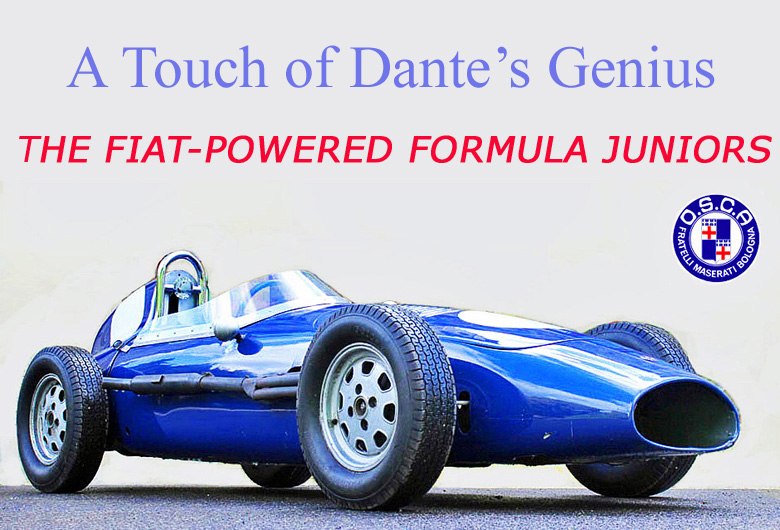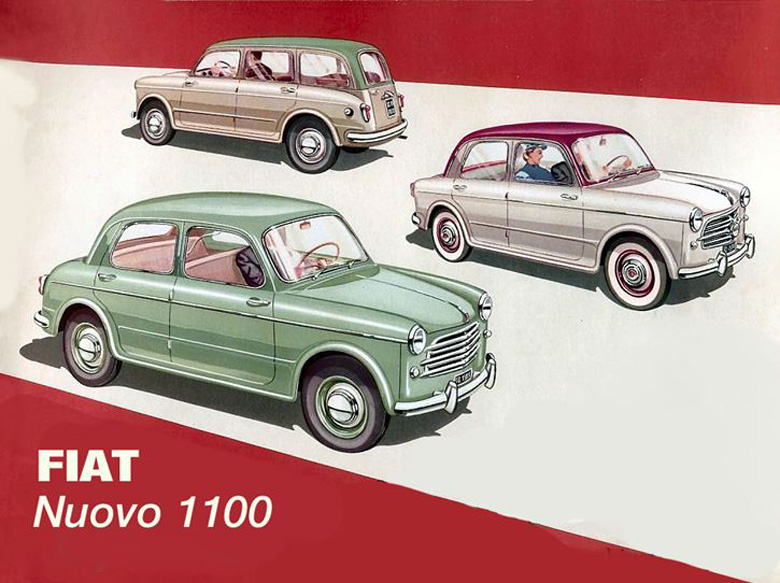By Gijsbert-Paul Berk and friends
The text of the lead photo is a bit too small to see clearly, but it is worth reading:
The Online Magazine for Italian and French Classic Car Enthusiasts
By pete
By pete

Meico Koudstaal owned this OSCA Formula Junior car several years and participated it in many races on European circuits. Photos courtesy Coys Classic Auto Auctions
Story by Gijsbert-Paul Berk
The Formula Junior was the brain child of Giovanni “Johnny’ Lurani, an Italian nobleman, engineer, racing driver, speed record holder, author, publisher and the Italian representative in the CSI (International Sporting Commission) of the FIA, the governing body for automobile sports. Like Piero Dusio before him, he saw the need for a new formula for affordable single-seater racing cars, allowing a new generation of drivers to gain experience. True or not, at the time some thought and even wrote that Lurani promoted his Formula Junior idea to compensate for the lack of success of Italian cars and drivers in the British dominated 500 cc. Formula 3. However, in October 1958 the FIA officially recognized the International Formula Junior.
By pete
By Gijsbert-Paul Berk and friends
With over 30 color photos by Hugues Vanhoolandt
Previously in a series of four installments, Gijsbert-Paul Berk covered the prewar beginnings of the Fiat 1100 in 1937 up to the introduction of the Nuovo 103 and the final Italian version, the 1100R which ceased production in 1969. A long and glorious history, to be sure.
But there is always more to this interesting story of one of Italy’s greatest cars. Initially, for this episode, we planned to show just a few of the special-bodied 1100s that graced the auto shows in the 1950s, such as the gorgeous Allemano, below. Then Hugues Vanhoolandt sent along a huge selection of Fiat 1100-based cars that also included many of the sports-racers which used 1100 components. The result is below. And bear with us, the story of a Touch of Dante’s Genius is not done yet!
By pete

The three versions of their Nuovo 1100: The Berlina, the Familiare and the more sporting TV (Turismo Veloce), recognizable by the extra lamp mounted in center of the radiator grill. Photo courtesy Fiat.
Story by Gijsbert-Paul Berk and friends
In the continuing saga of the Fiat 1100, Gijsbert-Paul Berk presents the line of 1089 cc Fiats from the 1953 Nuovo 103 to the final variant, the 1969 1100 R.
The postwar European economic boom created demand for workers in the industrialized triangle between the cities of Milan, Turin and Genoa. Around 9 million Italians moved from poor rural and mainly agricultural areas to find employment there. During those years, the Italian GPD grew with an average of 5.8% per year, very close to the German growth rate; the purchasing power of the population rose accordingly.
By pete
Review by Pete Vack
All images from the book
At his home in old Wales near an ancient Norman castle, David Beare, historian extraordinaire, does his own thing and we are glad of this, because of his wonderful look at the flat twins of Panhard published in 2012, a two part history of Hispano Suiza and Pegaso published in 2017, and his comprehensive look at Fiat, Volume 1, which was completed early last year.
And we are now very happy to see that Fiat Volume 2, which takes the narrative from 1950 to 1979, has been finished and is available worldwide. In Volume 1, we enjoyed Beare’s use of colorful graphics, interesting anecdotes, and his knack of including social history as a means of background and to provide a deeper understanding of the forces that shaped the history of the company. [Read more…] about Fiat: Thirty Years of Progress Reviewed
By pete
Review by Pete Vack
If you own a Ferrari, Maserati, Lancia, Abarth, any Etceterini, Alfa Romeo, Fiat or even OM, it might be beneficial to bone up on the history of Fiat as a parent company. A good time to do it as well, for 2019 marks the 120th anniversary of Fiat. [Read more…] about The First Fifty Years of Fiat: A Review
By pete
By Pete Vack and Alex Vazeos
Geburth Fiat Photos courtesy of Alex Vazeos
From the VeloceToday Archives, March 2012
What about sending an Italian chassis out of Italy to have coachwork built? The normal direction would be to send your chassis to Italy where it would be given a fine set of new clothes by one of the famous carrozzerias that dotted the landscape in the 50s and 60s. It would be unique, well done, inexpensive and probably beautiful. Being contrary then would involve having a chassis made in Italy bodied in some country not particularly known for automobiles and automobile design, like Austria. [Read more…] about Remarkable Fiat Geburth: The Full Story
By pete
By pete

Meico Koudstaal owned this OSCA Formula Junior car several years and participated it in many races on European circuits. Photos courtesy Coys Classic Auto Auctions
Story by Gijsbert-Paul Berk
The Formula Junior was the brain child of Giovanni “Johnny’ Lurani, an Italian nobleman, engineer, racing driver, speed record holder, author, publisher and the Italian representative in the CSI (International Sporting Commission) of the FIA, the governing body for automobile sports. Like Piero Dusio before him, he saw the need for a new formula for affordable single-seater racing cars, allowing a new generation of drivers to gain experience. True or not, at the time some thought and even wrote that Lurani promoted his Formula Junior idea to compensate for the lack of success of Italian cars and drivers in the British dominated 500 cc. Formula 3. However, in October 1958 the FIA officially recognized the International Formula Junior.
By pete
By Gijsbert-Paul Berk and friends
With over 30 color photos by Hugues Vanhoolandt
Previously in a series of four installments, Gijsbert-Paul Berk covered the prewar beginnings of the Fiat 1100 in 1937 up to the introduction of the Nuovo 103 and the final Italian version, the 1100R which ceased production in 1969. A long and glorious history, to be sure.
But there is always more to this interesting story of one of Italy’s greatest cars. Initially, for this episode, we planned to show just a few of the special-bodied 1100s that graced the auto shows in the 1950s, such as the gorgeous Allemano, below. Then Hugues Vanhoolandt sent along a huge selection of Fiat 1100-based cars that also included many of the sports-racers which used 1100 components. The result is below. And bear with us, the story of a Touch of Dante’s Genius is not done yet! [Read more…] about A Touch of Dante’s Genius Continues
By pete

The three versions of their Nuovo 1100: The Berlina, the Familiare and the more sporting TV (Turismo Veloce), recognizable by the extra lamp mounted in center of the radiator grill. Photo courtesy Fiat.
Story by Gijsbert-Paul Berk and friends
In the continuing saga of the Fiat 1100, Gijsbert-Paul Berk presents the line of 1089 cc Fiats from the 1953 Nuovo 103 to the final variant, the 1969 1100 R.
Read Part 1
Read Part 2
Read Part 3
The postwar European economic boom created demand for workers in the industrialized triangle between the cities of Milan, Turin and Genoa. Around 9 million Italians moved from poor rural and mainly agricultural areas to find employment there. During those years, the Italian GPD grew with an average of 5.8% per year, very close to the German growth rate; the purchasing power of the population rose accordingly. [Read more…] about A Touch of Dante’s Genius: 1100/103 to 1100 R